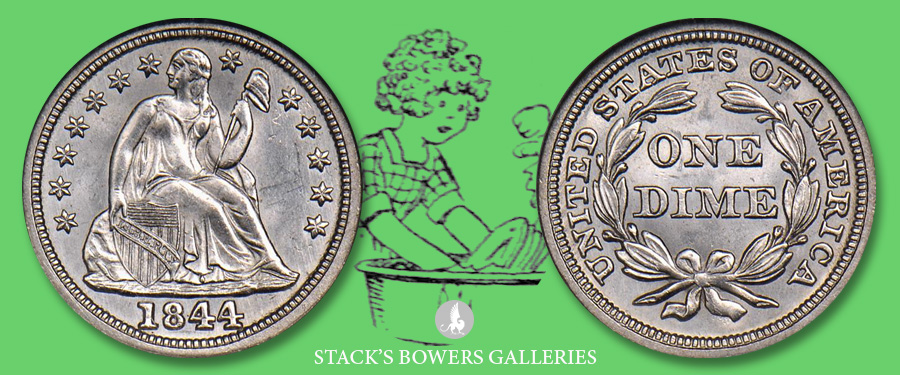
Though its mintage is on the smaller side for the series, it’s hard to imagine the 1844 Seated Liberty dime as an “Orphan,” as hundreds, if not 1,000 or more are known. The Philadelphia Mint used one pair of dies to strike 72,500 dimes (cataloged as Fortin-102) in 1844; these coins were the subject of considerable numismatic mythmaking in the following century and a half as collectors, dealers, and researchers struggled to find a suitable explanation for the date’s relative rarity. The dimes are at the center of stories of lovelorn soldiers in the Mexican-American War, shipwrecks, wagon trains waylaid by Native Americans, the Great Chicago Fire, the Great Johnstown Flood, and other calamities. This fun 2007 Numismatic News story by Robert R. Van Ryzin relates many of the tall tales.
The coins themselves are scarce relative to their 1840s and 1850s compatriots. Small mintages from the Philadelphia Mint were common during the Civil War but from the new design’s introduction in 1837 to the early 1860s, mintages over one million were the norm from that facility.
It was in the early 1930s that the 1844 dimes received their distinctive nickname. Frank Ross, longtime Numismatic section editor of Hobbies magazine and author of the “Numismatic Thoughts” column in the same, christened them the “Little Orphan Annie,” connecting the date’s small mintage and relative rarity to the popular conservative 1920s comic strip that spawned a range of other media in following decades.
Ross’ moniker was not purely whimsical; he was, according to some, engaged in what numismatic historian Leonard Augsburger describes in a 2017 E-Gobrecht article as “numismatic duplicity well practiced”, in this case hoarding examples of the 1846 Seated Liberty dime (which has a smaller mintage), but publicly promoting the 1844. Many accounts claim that Ross hoarded 1844 dimes, but it seems he was hoarding the 1846.





